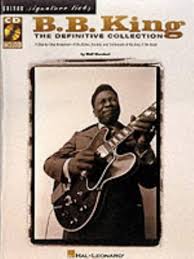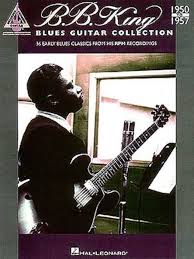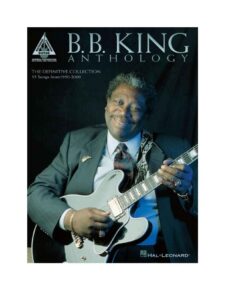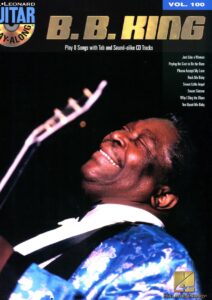
Come join us now, and enjoy playing your beloved music and browse through great scores of every level and styles!
Can’t find the songbook you’re looking for? Please, email us at: sheetmusiclibrarypdf@gmail.com We’d like to help you!
Table of Contents
Remembering B.B. King, born on this day in 1925 (1925-2015).

B.B. King – The Thrill Is Gone [Crossroads 2010] (Official Live Video) with Eric Clapton
Best Sheet Music download from our Library.

Please, subscribe to our Library.
If you are already a subscriber, please, check our NEW SCORES’ page every month for new sheet music. THANK YOU!
The King of the Blues: An Exhaustive Study of B.B. King

Browse in the Library:
Or browse in the categories menus & download the Library Catalog PDF:
The King of the Blues: An Exhaustive Study of B.B. King
To speak of the blues is to speak of B.B. King. For over half a century, his name was synonymous with the genre itself. He was its most recognizable ambassador, a tireless performer who played over 300 shows a year well into his later decades, and a master musician whose expressive voice and singular guitar style fundamentally shaped the sound of modern music. From the cotton fields of Mississippi to the world’s most prestigious stages, his journey is the quintessential American blues narrative. This article delves deep into the biography, musical genius, collaborations, and enduring legacy of Riley B. King, the one and only “King of the Blues.”
Biography: From Indianola to Immortality

Early Life and Humble Beginnings (1925-1946)
Riley B. King was born on September 16, 1925, on a cotton plantation near the small town of Itta Bena, Mississippi. His parents, Albert and Nora Ella King, separated when he was four, and his mother died shortly thereafter. Young Riley was subsequently raised by his maternal grandmother. Life was defined by grueling poverty and the back-breaking work of a sharecropper. The blues was not just music; it was the audible texture of this life—the field hollers, the spirituals sung in church, and the guitar playing of his pastor, Archie Fair, who gave him his first musical inspiration.
At the age of 12, King saved up $15 to buy his first guitar. His musical education came from listening to blues records by Blind Lemon Jefferson, Lonnie Johnson, and T-Bone Walker, and to the radio, where the sounds of jazz giants like Django Reinhardt and Charlie Christian captivated him. In 1943, he left Mississippi for Memphis, Tennessee, to pursue music but was soon drafted into the U.S. Army during World War II. After his service, he returned to Indianola, Mississippi, to work as a tractor driver, but the dream of music persisted.
The Break in Memphis and Becoming “Beale Street Blues Boy” (1948-1950)
In 1946, King made his second, permanent move to Memphis, moving in with his cousin, the established bluesman Bukka White. For ten months, White gave him intensive lessons on guitar and tutored him in the ways of the music business. King began performing on street corners for change and eventually secured a ten-minute spot on Sonny Boy Williamson II’s radio program on WDIA, the first radio station in the U.S. programmed entirely by Black Americans.
His talent was immediately evident, and he soon gained a regular spot as a DJ and performer on WDIA. It was here that he earned the nickname that would define him: first, he was called “the Beale Street Blues Boy,” which was shortened to “Blues Boy,” and finally, to “B.B.” His on-air persona was warm and witty, and he began to build a significant local audience. In 1949, he made his first recordings for the small label Bullet Records.
Rise to National Prominence (1950s-1960s)
In 1950, King signed with the larger RPM Records, run by the Bihari brothers. It was during this time that he formed his famous band and christened his guitar “Lucille.” The apocryphal story originates from a performance in Twist, Arkansas, where a fight over a woman named Lucille broke out, knocking over a kerosene heater and starting a fire. King ran back into the burning building to save his $30 Gibson guitar, nearly dying in the process. He thereafter named his guitars “Lucille” as a reminder to never do something so foolish again.
His first national R&B hit came in 1951 with “Three O’Clock Blues,” which stayed at number one for 15 weeks. A string of hits followed, including “You Know I Love You,” “Woke Up This Morning,” “Please Love Me,” “You Upset Me Baby,” “Sweet Little Angel,” and “Every Day I Have the Blues.” Throughout the 1950s, B.B. King was a consistent presence on the R&B charts, tirelessly touring the “Chitlin’ Circuit” of Black-owned clubs and theaters across the South and Midwest.

Crossover and Global Acclaim (1960s-1990s)
The 1960s saw the rise of rock ‘n’ roll, and many British Invasion bands, like The Rolling Stones and John Mayall’s Bluesbreakers, openly cited B.B. King as a primary influence. This introduced his music to a new, young, white audience. His incendiary performance at the 1967 Newport Folk Festival was a watershed moment, captured on film and stunning an uninitiated crowd.
However, it was the 1969 recording of “The Thrill Is Gone” that cemented his status as a global superstar. The song, with its haunting string arrangement and King’s soul-wrenching vocal and guitar performance, became a crossover pop hit, winning a Grammy Award. Suddenly, B.B. King was playing rock venues like the Fillmore West for audiences who revered him as a founding father of their own musical heroes.
For the next three decades, King was a relentless international touring machine, playing for presidents and kings while never losing the common touch that made him beloved.
Later Years and Legacy (2000-2015)
Even as he entered his 80s, B.B. King continued to perform over 100 shows a year, though his health began to decline, leading to his retirement from touring in 2014. He passed away peacefully in his sleep on May 14, 2015, at the age of 89. His death was met with an outpouring of grief from across the musical spectrum, a testament to his universal appeal and profound influence.
Music Style and Improvisational Licks: The Voice of Lucille
B.B. King’s style is instantly recognizable, a perfect marriage of vocal and instrumental expression.
The Guitar Style:
King did not play complex, flashy lines or use technical pyrotechnics. His genius lay in his profound economy and emotional depth. He was a master of “call and response,” where he would sing a line and his guitar, Lucille, would answer it with a perfectly phrased, vocal-like lick.
His technical hallmarks include:
- Vibrato: King’s vibrato is arguably his most identifiable characteristic. It was a wide, intense, hand-controlled wobble achieved by pressing the string and rapidly rocking the wrist and hand (not just the finger). This gave his notes a crying, human-voice-like quality.
- String Bending: He perfected the art of bending strings to reach specific, expressive pitches, often microtonal “blue notes” that lay between the cracks of the standard Western scale. His bends were precise and full of feeling.
- Economy of Notes: Unlike players who favored rapid flurries of notes, King believed in the power of a single, perfectly chosen and phrased note. He would let notes sustain and sing, wringing every ounce of emotion from them before moving to the next. His solos were stories in themselves.
- The “Butterfly” Shake: A specific technique where he would quickly flutter his fretting hand on a bent string to create a fluttering, nervous, and intensely emotional effect.
Signature Licks:
Many of his licks are built from the minor pentatonic and blues scales, but his phrasing is what made them unique.
- The “B.B. Box”: A classic box pattern centered around the 12th fret, often starting on the B string (e.g., 15b17-15 on the B string, answered by 15 on the high E string).
- The “Gut Punch” Bend: A full-step bend on the G string (e.g., bending the 12th fret to the pitch of the 14th) followed by a rapid vibrato. This is a hallmark of his style, a declarative, powerful statement.
- Response Phrases: Short, melodic phrases that often descend and resolve, mimicking a sigh or a mournful cry. These are rarely flashy but are always perfectly placed to answer his vocal line.
Cooperation with Other Artists: The Universal Ambassador
B.B. King’s collaborative spirit knew no bounds. He duetted with artists from every conceivable genre, always meeting them on their turf while remaining unmistakably himself.
- Rock & Roll: His 1968 album with a band of rock session pros, “Lucille,” was an early crossover attempt. He recorded with The Rolling Stones and toured with U2.
- Soul & R&B: He made a classic album with Bobby Bland, Together Again…Live, a meeting of two blues giants. His work with Stevie Wonder and others was always deeply soulful.
- Jazz: His album with jazz trumpet great Dizzy Gillespie demonstrated their shared language of sophisticated improvisation.
- Pop: His collaboration with U2 on “When Love Comes to Town” for their Rattle and Hum film introduced him to a whole new generation.
- The “Blues Summit” Albums: In the 1990s, he released a series of albums like Blues Summit and Deuces Wild that featured duets with a who’s who of music, including Eric Clapton, Robert Cray, Bonnie Raitt, Van Morrison, Willie Nelson, and Heavy D.
- Eric Clapton: His most famous collaboration was with fellow guitar titan Eric Clapton. Their 2000 album “Riding with the King” was a multi-platinum, Grammy-winning success, a perfect blend of Clapton’s British blues-rock and King’s deep Delta roots.
Chord Progressions and Music Harmony: The Foundation of the Feeling
B.B. King’s music is built on the foundational structures of blues and jazz harmony.
Standard Blues Progressions:
The vast majority of his catalog is based on the standard 12-bar blues and 8-bar blues forms, almost always in a 4/4 time signature.
- The 12-Bar Blues (I-IV-V): This is the bedrock. A song like “Every Day I Have the Blues” is a textbook example: four bars of the I chord, two bars of the IV chord, two bars of the I chord, one bar of the V chord, one bar of the IV chord, and two bars of the I chord (often with a “turnaround” lick to bring it back to the top).
- The 8-Bar Blues: Used in classics like “The Thrill Is Gone,” which follows a more melancholic, minor-key 8-bar structure.
Jazz Influence and Sophistication:
What set King’s band apart was the sophisticated harmonic language they employed over these simple structures. Drawing from his love for big band jazz and artists like Count Basie and Django Reinhardt, his arrangements often featured:
- Walking Bass Lines: His bass players would outline complex chord changes within the 12-bar framework.
- Horn Arrangements: The horn section (trumpet, saxophone) didn’t just play riffs; they played intricate, jazz-inspired arrangements with lush, extended chords (9ths, 13ths, diminished chords) that added a layer of sophistication and swing.
- The “B.B. King Shuffle”: A specific, swinging rhythm feel often in a 12/8 time signature that gave his music a relaxed, rolling groove perfect for both dancing and deep listening. Tracks like “The Thrill Is Gone” and “How Blue Can You Get?” are masterclasses in this feel.
Influences: The Roots of the Tree
B.B. King’s style was a synthesis of his musical environment:
- Blues Guitarists: T-Bone Walker was his greatest influence—the first bluesman King heard play electric guitar with a jazzy, single-string soloing style. Blind Lemon Jefferson (for his raw emotion), Lonnie Johnson (for his sophisticated, single-note lines), and his cousin Bukka White (for his powerful slide style) were also critical.
- Jazz Musicians: Django Reinhardt and Charlie Christian inspired his approach to melodic, horn-like improvisation.
- Gospel and Spirituals: The raw emotional power of the church music of his childhood informed his vocal delivery—the shouts, the moans, the testifying quality.
- Popular Vocalists: He often cited crooners like Frank Sinatra and Nat King Cole as influences on his phrasing and his desire to deliver a lyric with clarity and emotion.
Legacy: The Eternal King
B.B. King’s legacy is immeasurable. He is the crucial bridge between the acoustic Delta blues of Robert Johnson and the electric blues-rock of Eric Clapton, Jimi Hendrix, and Stevie Ray Vaughan. He democratized the blues, making it accessible and relatable to a global audience without diluting its power.
He proved that a single, well-chosen note could be more powerful than a hundred technical ones. He commercialized the blues without compromising its integrity. His work ethic, generosity, and humble nature made him a beloved figure personally and professionally. Every guitarist who has ever bent a string to express emotion is in his debt.
Works, Filmography, and Most Known Compositions
Most Known Compositions and Performances:
While King was a brilliant interpreter of songs written by others, his performances made them his own.
- “The Thrill Is Gone” (his signature song, written by Roy Hawkins and Rick Darnell)
- “Every Day I Have the Blues” (written by Memphis Slim)
- “Sweet Little Angel”
- “How Blue Can You Get?”
- “3 O’Clock Blues”
- “Rock Me Baby”
- “Nobody Loves Me But My Mother” (and she could be jivin’ too)
- “Why I Sing the Blues”
- “Paying the Cost to Be the Boss”
Filmography:
King appeared in numerous films and TV shows, often as himself.
- The Blues Brothers (1980)
- U2: Rattle and Hum (1988)
- Spies Like Us (1985)
- Into the Night (1985)
- Blues Brothers 2000 (1998)
- Numerous documentaries, including the PBS series The Blues by Martin Scorsese.
Discography: A Selection of Essential Albums
B.B. King recorded over 50 studio and live albums. Key entries include:
- Singin’ the Blues (1957)
- The Blues (1958)
- Live at the Regal (1965) – Often cited as the greatest live blues album ever recorded.
- Blues Is King (1967)
- Lucille (1968)
- Completely Well (1969) – Features “The Thrill Is Gone.”
- Indianola Mississippi Seeds (1970)
- Live in Cook County Jail (1971)
- Riding with the King (2000) – with Eric Clapton
- One Kind Favor (2008) – A late-career masterpiece produced by T-Bone Burnett, which won a Grammy for Best Traditional Blues Album.
B.B. King’s life was the blues, and the blues was his life. He took a regional style and turned it into a universal language of heartache, resilience, and ultimately, joy. He was a true American icon, and the voice of Lucille will continue to thrill and inspire for as long as people need music to speak the words they cannot say.
Listen to B.B. King’s music on Spotify
Browse in the Library:
Or browse in the categories menus & download the Library Catalog PDF:
